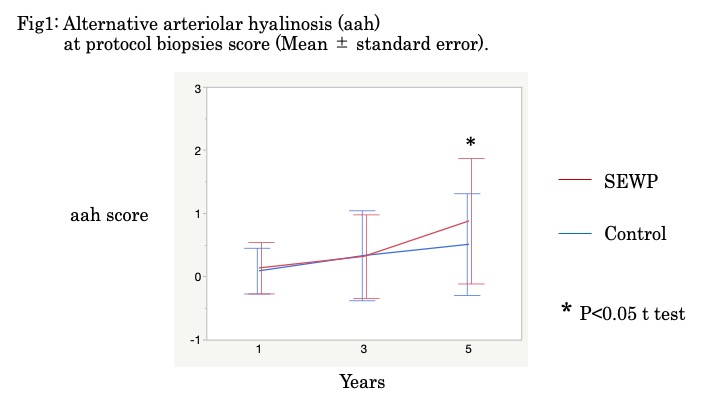Steroids Ameriplate the Progression of Calcineurin Inhibitors Nephrotoxicity in Kidney Allografts
1Hokkaido University, Sapporo, Japan, 2Sapporo City General Hospital, Sapporo, Japan
Meeting: 2020 American Transplant Congress
Abstract number: D-100
Keywords: Calcineurin, Inflammation
Session Information
Session Name: Poster Session D: Kidney Immunosuppression: Novel Regimens and Drug Minimization
Session Type: Poster Session
Date: Saturday, May 30, 2020
Session Time: 3:15pm-4:00pm
 Presentation Time: 3:30pm-4:00pm
Presentation Time: 3:30pm-4:00pm
Location: Virtual
*Purpose: Although calcineurin inhibitors (CNI) lead to excellent short-term kidney allograft outcome, chronic nephrotoxicity is a major concern which affects long-term allograft survival. It has been reported that CNI induce proinflammatory activity in tubular cells and microvascular endothelial cells to induce chronic inflammation and ischemia, leading to allograft damage. Thus, we hypothesized that steroids co-administered with CNI may suppress the progression of CNI nephrotoxicity via steroid’s anti-inflammatory effects.
*Methods: We retrospectively analyzed the clinical records of 186 living-donor kidney transplant recipients between 2002 and 2013. Among them, 102 recipients were treated with steroid early withdrawal protocols (SEWP: steroid was withdrawn at 3 days after kidney transplantation), and 84 with continuous steroid protocols (Control group: daily 2 or 4 mg of methylprednisolone). All patients received tacrolimus (TAC), mycophenolate mofetil (MMF), and basiliximab as an induction therapy. Histological findings at 1, 3, and 5 years protocol biopsies were reviewed and compared CNI toxicity between the two groups.
*Results: There was no difference in the recipients’ characteristics between the 2 groups. Chronic lesions scores (ci: interstitial fibrosis, ct: tubular atrophy, cv: fibrointimal thickening) didn’t increase over the observational period, and there was no difference in these scores between the 2 groups at 5 years. Alternative arteriolar hyalinosis score (aah, according to Banff criteria 2013) increased over time in both groups (0.13±0.40, 0.32±0.60, and 0.89±0.99 in SEWP group at 1, 3, and 5 years, and 0.08±0.35, 0.32±0.70, and 0.51±0.80 in the Control group, respectively), and there was a significant difference (p=0.04, by unpaired t test) at 5 years after transplant (Fig1). TAC trough levels were comparable between SEWP and Control group at 5 years (SEWP vs Control: 3.47±0.27 ng/mL and 4.05±0.28 ng/mL). However, estimated glomerular filtration rate at 5 years were similar in 2 groups (SEWP vs Control: 51.2±1.8 mL/min vs 49.3±1.4 mL/min), and there were no graft loss cases due to CNI nephrotoxicity.
*Conclusions: Our analysis shows that aah score specific for CNI toxicity was significantly higher in SEWP at 5 years under similar exposure to TAC, suggesting that steroids may have protective effects against CNI toxicity.
To cite this abstract in AMA style:
Iwahara N, Sasaki H, Iwami D, Hotta K, Takada Y, Higuchi H, Tanabe T, Shinohara N. Steroids Ameriplate the Progression of Calcineurin Inhibitors Nephrotoxicity in Kidney Allografts [abstract]. Am J Transplant. 2020; 20 (suppl 3). https://atcmeetingabstracts.com/abstract/steroids-ameriplate-the-progression-of-calcineurin-inhibitors-nephrotoxicity-in-kidney-allografts/. Accessed December 20, 2025.« Back to 2020 American Transplant Congress

